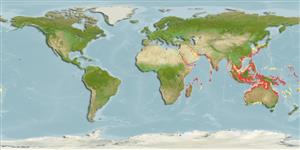Common names from other countries
Environment: milieu / climate zone / depth range / distribution range
Sinh thái học
; Mức độ sâu 5 - 310 m (Ref. 125642). Tropical
Indo-West Pacific: from the Red Sea to China and Australia.
Length at first maturity / Bộ gần gũi / Khối lượng (Trọng lượng) / Age
Maturity: Lm ?, range 8 - 9.5 cm Max length : 17.0 cm CW con đực/không giới tính; (Ref. 343)
Carapace densely covered with very short pubescence which is absent on several distinct transverse granulated ridges in anterior half. Color: orangish red overall, with ridges on carapace and legs dark and reddish brown.
Maximum depth from Ref. 801. Contributes to fisheries in India and Australia (Ref. 106287). Occurs at depths from intertidal to 50 m (Ref. 801). Subtidal (Ref. 106854). Inhabits rocky areas (Ref. 801), sandy-rocky areas (Refs. 343, 106287), corals reefs (Ref. 801) and areas near coral reefs (Ref. 343). Also found on substrates of sand or sandy mud (Ref. 125642). Subtropical and tropical climates (Ref. 343).
Mating behavior: Precopulatory courtship ritual is common (through olfactory and tactile cues); usually indirect sperm transfer (Ref. 833).
MarineSpecies.org. 2050. (Ref. 3477)
IUCN Red List Status (Ref. 130435)
CITES status (Ref. 108899)
Not Evaluated
Not Evaluated
Threat to humans
Poisonous to eat (Ref. 130554)
Human uses
Các nghề cá: Tính thương mại
| FishSource |
Các công cụ
Các nguồn internet
Estimates based on models
Preferred temperature
(Ref.
115969): 24.5 - 29.2, mean 28.1 (based on 1314 cells).
Thích nghi nhanh
Chiêù cao, thời gian nhân đôi của chủng quần tối thiểu là dưới 15 tháng (K=1.1-1.6).
Vulnerability
Low vulnerability (10 of 100).
Price category
Unknown.
